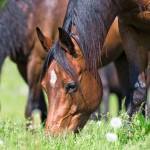Foraging Behavior, Herd Hierarchy, and Body Condition in Horses

Nutritional management of horses in a herd situation can be challenging, especially when hay must be fed due to pasture dormancy or use of a drylot. Researchers recently conducted a study to better understand the connection between foraging behavior, social dominance, and body condition.
In the study, 116 horses were arranged in 20 small herds and observed for two three-hour periods each day during the winter months. The time of year was chosen specifically because horses would be more likely to interact with one another as hay, their only source of forage, was offered in communal feeders. Observation periods coincided with replenishment of hay in the feeders.
The researchers summarized the most important findings:
- Those horses tagged as more dominant have a higher body condition score (BCS). Subordinate horses spend more time moving as a result of being displaced from forage sources. While dominant horses also have to interrupt their feeding to manage a subordinate, their breaks in foraging are much briefer than those of the subordinates.
- Horses with a higher BCS have better foraging efficiency, meaning that the ratio of energy gained to energy expended was high.
- Factors other than social dominance can also affect BCS. Highly vigilant horses have decreased foraging efficiency. Vigilance does not necessarily imply dominance, as vigilance refers to horses that appear to act on behalf of the group to conduct predator surveillance, monitor herdmates, and scan the environment for resources.
“This study shows that attention must be given to all horses in a herd to ensure they maintain appropriate condition and consume adequate forage. This is important in the winter when forage is not particularly plentiful but may also be necessary in times when forage is scarce,” said Kathleen Crandell, Ph.D., a Kentucky Equine Research nutritionist.
Because all horses must receive requisite nutrients in their diet for optimal health, a well-balanced feed or a ration balancer purchased from a reputable manufacturer should be fed alongside forage.
If fresh, green pasture isn’t available, owners should consider vitamin E supplementation. “Vitamin E levels in hay steadily decline with storage. If hay is the only source of vitamin E for the horse, supplementation with a natural-source vitamin E, such as Nano-E, is recommended to reduce the risk of deficiency later,” said Crandell. Long-term deficiency of vitamin E can cause neuromuscular disease.
Finally, weight should be managed in those dominant horses to prevent obesity and obesity-related metabolic diseases. Whenever possible, it is best to group horses by their nutritional requirements—easy keepers in one group, hard keepers in another, for example. This simplifies management as the horses within a group will likely have similar nutritional needs.
*Giles, S.L., P. Harris, S.A. Rands, and C.J. Nichol. 2020. Foraging efficiency, social status and body condition in group-living horses and ponies. PeerJ 8:e10305.








